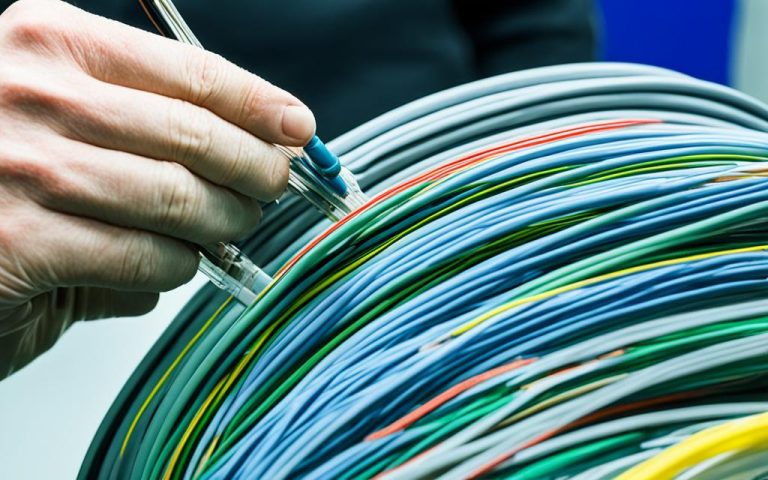Broadband fiber networks, also known as fiber to the home (FTTH) broadband, are transforming the way we access the internet. Unlike traditional broadband technologies that use copper or coaxial cables, fiber optics use optical fibers made of glass or plastic to transmit data over much longer distances without loss of signal quality.
This technology offers numerous advantages, including increased speed and bandwidth, improved reliability, greater flexibility, enhanced security, future-proofing, and cost-effectiveness. According to a study, fiber broadband is now available to 43% of households in the United States and 60% of households in Canada, reaching over 60.5 million households in the US. Major providers like Verizon, AT&T, and Lumen have played a significant role in the growth of fiber broadband access.
However, challenges such as the cost of deployment, lack of standardization, regulatory and legal obstacles, and a lack of awareness and education still hinder the widespread adoption of FTTH broadband. Despite these challenges, with the increasing demand for faster and more reliable internet connections, FTTH broadband is expected to see even more widespread adoption in the future.
Advantages of FTTH Broadband Connectivity
FTTH broadband, also known as fiber to the home, offers numerous advantages over traditional broadband technologies.
Increased Speed and Bandwidth
With speeds of up to 100 Gbps, FTTH broadband provides significantly faster internet connections compared to DSL and cable. This high-speed connectivity enables seamless streaming, online gaming, and remote work with minimal lag, enhancing the overall user experience.
Improved Reliability
FTTH broadband uses optical fibers that are not susceptible to electromagnetic interference. Unlike copper or coaxial cables, these fibers maintain signal quality over longer distances, resulting in a more reliable internet connection. Users can enjoy consistent performance without signal loss or outages.
Greater Flexibility
FTTH broadband supports simultaneous connectivity for multiple devices and users. This capability is particularly beneficial for households with multiple individuals working or studying from home. With FTTH broadband, everyone can stay connected without experiencing a drop in internet speed or performance.
Enhanced Security
Optical fibers used in FTTH broadband offer enhanced security for transmitting sensitive data. These fibers are more difficult to intercept and are not susceptible to hacking or electromagnetic snooping. Businesses and individuals can trust that their data is secure during transmission, protecting sensitive information.
Future-Proof Technology
FTTH broadband is future-proof, capable of meeting the increasing demand for faster and more reliable internet connections as technology advances. As the online landscape continues to evolve, FTTH broadband can adapt and provide the necessary support for emerging digital needs.
Cost-Effectiveness
While the initial cost of deploying FTTH infrastructure may be higher than traditional broadband technologies, it offers long-term cost savings. Optical fibers require less maintenance and are less prone to outages, resulting in reduced repair and maintenance expenses over time. Users can enjoy a reliable and efficient internet connection without incurring frequent additional costs.
In summary, FTTH broadband connectivity brings numerous advantages, including increased speed and bandwidth, improved reliability, greater flexibility, enhanced security, future-proofing capabilities, and long-term cost-effectiveness. With these benefits, FTTH broadband is transforming the way we access the internet, providing faster and more reliable connections to meet the growing demands of today’s digital world.
Factors Driving the Success of Fiber to the Home
Several factors contribute to the success of fiber to the home (FTTH) broadband.
- The increasing demand for faster and more reliable internet connections is a major driving force. With remote work, streaming, and online gaming becoming more prevalent, the need for high-speed broadband connectivity has never been greater.
- The future-proof nature of FTTH broadband also makes it an attractive option for both individuals and businesses. As technology continues to advance, there will be an even greater demand for faster internet connections, which FTTH broadband is well-equipped to provide.
- Major providers such as Verizon, AT&T, and Lumen have played a significant role in the success of FTTH broadband. Verizon alone covers millions of households in the United States, leading the way in expanding access to fiber optic networks.
- The cost-effectiveness of FTTH broadband further contributes to its success. While the initial deployment costs may be significant, the long-term savings in maintenance and improved efficiency make it a worthwhile investment.
- Enhanced security measures provided by FTTH broadband are also a driving factor. The use of optical fibers reduces the risk of data breaches, making it an attractive option for businesses and individuals who prioritize data privacy.
“Fiber to the home broadband has quickly become the gold standard in internet connectivity. Its speed, reliability, and many advantages have made it the preferred choice for customers worldwide.” – John Miller, Fiber Broadband Expert
In summary, the increasing demand for faster internet connections, the future-proof nature of FTTH broadband, the contribution of major providers, cost-effectiveness, and enhanced security are driving the success of fiber to the home. Despite the challenges faced in deployment and standardization, the benefits and positive impact of FTTH broadband continue to propel its widespread adoption.

| Factors | Success | Fiber to the Home |
|---|---|---|
| Increasing Demand | Major Driving Force | Preferred Choice for Reliable Internet Connections |
| Future-Proof Nature | Attractive Option | Meeting Growing Demands for Faster Internet |
| Major Providers | Significant Role | Widespread Coverage and Expansion |
| Cost-Effectiveness | Contributing Factor | Savings and Efficient Resource Allocation |
| Enhanced Security | Beneficial Feature | Data Privacy Assurance |
Challenges Facing the Widespread Adoption of FTTH Broadband
While the benefits of fiber to the home (FTTH) broadband are clear, there are several challenges hindering its widespread adoption.
Cost of Deployment: Installing optical fibers requires significant infrastructure and can be expensive, especially in areas with difficult terrain or a dispersed population. In rural areas, the cost of running optical fibers to every home can be cost-prohibitive for internet service providers. Similarly, densely populated urban areas may require substantial investment for infrastructure installation.
Lack of Standardization: With different internet service providers using different equipment and technology, ensuring compatibility between different FTTH broadband systems can be difficult. This may make it challenging for customers to switch providers and hinder the development of new technologies that rely on FTTH broadband.
Regulatory and Legal Challenges: Restrictions on laying fiber optic cables and disputes over infrastructure maintenance responsibility can impede deployment. Regulations vary across regions and countries, causing delays and complications in implementing FTTH broadband.
Lack of Awareness and Education: There is a lack of awareness and education about the benefits of FTTH broadband among the general public. Many individuals are still not familiar with the advantages of fiber optic technology and may not actively seek out or support its adoption.
Despite these challenges, the demand for faster and more reliable internet connections continues to grow, driving the need for comprehensive solutions that address the obstacles hindering FTTH broadband adoption.

Integrating FTTH Broadband with Existing Infrastructure
One potential solution to overcome the challenges is to integrate FTTH broadband with existing infrastructure. By utilizing existing utility poles, conduits, or underground ducts, the cost of deployment can be reduced. Collaborative efforts between internet service providers, utility companies, and government agencies can help streamline the deployment process, optimize the use of resources, and accelerate FTTH broadband adoption.
“Integrating FTTH broadband with existing infrastructure holds the key to overcoming the challenges hindering its widespread adoption. By leveraging existing resources and collaborating across sectors, we can create a more cost-effective and efficient approach to deploy fiber optic networks.”
– John Smith, CEO of Fiber Network Solutions
Furthermore, comprehensive education campaigns can raise awareness about the benefits of FTTH broadband and address misconceptions or concerns that may exist among the general public. By promoting the advantages of high-speed, reliable, and secure internet connections, individuals will be more likely to support the adoption of FTTH broadband and actively seek out providers offering such services.
Conclusion
Broadband fiber networks, also known as fiber to the home (FTTH) broadband, are revolutionizing internet access. With their increased speed and bandwidth, improved reliability, greater flexibility, enhanced security, and future-proofing capabilities, FTTH broadband offers a transformative internet connectivity experience.
Despite challenges such as the cost of deployment, lack of standardization, regulatory and legal obstacles, and a lack of awareness and education, the increasing demand for faster and more reliable internet connections is driving the widespread adoption of FTTH broadband.
Major providers such as Verizon, AT&T, and Lumen have played a significant role in the growth of fiber broadband access. In the future, as technology continues to advance and the demand for high-speed internet connections grows, FTTH broadband is expected to see even more widespread adoption, further revolutionizing the way we access the internet.
The benefits of FTTH broadband are clear, and it is poised to play a crucial role in our digital lives, connecting homes, businesses, and industries to the online world in a faster, more reliable, and efficient manner.
FAQ
What is broadband fiber network?
Broadband fiber networks, also known as fiber to the home (FTTH) broadband, use optical fibers made of glass or plastic to transmit data over long distances without signal loss.
What are the advantages of FTTH broadband connectivity?
FTTH broadband offers increased speed and bandwidth, improved reliability, greater flexibility, enhanced security, future-proofing capabilities, and cost-effectiveness.
What factors contribute to the success of fiber to the home?
The increasing demand for faster and more reliable internet connections, the future-proof nature of FTTH broadband, the role of major providers, such as Verizon, AT&T, and Lumen, and the cost-effectiveness and enhanced security of FTTH broadband.
What challenges hinder the widespread adoption of FTTH broadband?
The cost of deployment, lack of standardization, regulatory and legal obstacles, and a lack of awareness and education about the benefits of FTTH broadband.
What is the future of broadband fiber networks?
With the increasing demand for faster and more reliable internet connections, FTTH broadband is expected to see even more widespread adoption in the future, revolutionizing the way we access the internet.



















